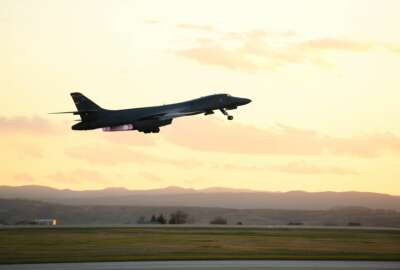
Pentagon says it’s working now to make sure JEDI hits the ground running
DoD CIO Dana Deasy says officials have been finding temporary homes for cloud applications that were counting on the long-delayed JEDI program. Other preparator...
The DoD Reporter’s Notebook is a weekly summary of personnel, acquisition, technology and management stories that may have fallen below your radar during the past week, but are nonetheless important. It’s compiled and published each Monday by Federal News Network DoD reporters Jared Serbu and Scott Maucione.
DoD CIO says officials have been finding homes for systems that have been waiting for JEDI
By the time all is said and done, investigations and lawsuits will have set the Defense Department’s JEDI Cloud program back by more than two years. But that doesn’t mean JEDI-related work has been at a standstill this entire time.
Dana Deasy, DoD’s chief information officer told reporters last week that work on at least some of the 14 pathfinder projects the department initially targeted for JEDI has moved ahead — it’s just that they’ve had to begin their lives in alternative cloud environments, such as the Air Force’s Cloud One/Platform One.
“I’m seeing more and more evidence that the cloud is nothing more than a facilitated environment that allows us to do what really matters, and that’s going to be DevOps and agile development,” he said. “When you read about [CloudOne,] they are learning to build software in very different ways that the cloud very much enables you to do. So what are we doing right now, we are doing a lot of work with the services on getting them prepared to move their development processes and cycles to DevOps so that when JEDI finally does [move ahead], we’re not starting at day one.”
But Deasy acknowledged that starting development in a different cloud environment has the potential to create integration challenges down the road, when it’s time to move those systems and applications to JEDI. Because of that, he said his office has been prioritizing the cloud development work that reflects urgent warfighter needs, particularly in tactical environments.
“When we all got together after JEDI was put on hold, we sat down with the team and said, ‘Okay, what are some of the principles we want to live by?’ First, we said, do no harm to the warfighter, and second, find homes for [cloud applications],” he said. “And in finding homes, I used the expression: we also need to help them find their way back home. Whatever platforms we were putting them on, whatever technologies and tools they were going to use, we needed to do our darndest to try to make sure that pivoting them back — if moving them back to JEDI was the right thing — would not be a Herculean task.”
Meanwhile, some aspects of the work that will eventually be needed to transition the department’s systems and applications onto JEDI have proceeded apace, because they’re not technically part of the JEDI contract, and consequently, aren’t subject to the Court of Federal Claims’ preliminary injunction.
“There’s tools that have to be identified, there’s integration environments to be identified there’s directories that have to be set up that allow people to connect into these worlds. That’s all work that we can continue to do, because it sits inside of our ownership already,” Deasy said.
The JEDI timeline is still highly uncertain.
According to a joint status report DoD and Amazon Web Services presented to the court last month, the government and AWS would not wrap up their written legal arguments until next February, and Judge Patricia E. Campbell-Smith would need additional time to consider the evidence and decide the case.
But that schedule could be extended by weeks or months if the judge grants Amazon’s request to add more evidence to the case’s administrative record or to conduct depositions. The company has asked permission to depose President Donald Trump, Deasy, former Defense Secretary James Mattis and others to help bolster its contention that the October 2019 contract award to Microsoft was colored by improper political influence. —JS
Future Defense Task Force gets praise and questions from military analysts
Experts from diverse ideological perspectives are praising the Congressional Future of Defense Task Force’s findings, but actually implementing the recommendations will take serious effort and funding from multiple government institutions.
The report, which was released last week, calls for Manhattan Project levels of attention to AI, divesting from legacy systems, increased research spending and further revamps to the acquisition system.
“The report’s recommendations align with many in the think tank community that also focus on building a force for great power conflicts,” Mark Cancian, senior adviser at the Center for Strategic and International Studies.
“Just like the wedding rhyme, in this report you can find ‘something old, something new, something borrowed and something blue,’” said Thomas Spoehr, director of national defense at the Heritage Foundation. “Some ideas, like establishing a Manhattan Project for Artificial Intelligence, or a global treaty on the use of AI, are old. There are some new items proposed, like a National Supply Chain Intelligence Center and ‘exponentially’ expanding the size of the State Department’s budget.”
Kea Matory, legislative director at the National Defense Industrial Association, said the report “combines what many experts have said in various arenas into a cohesive overview. Many of these topics are being looked at from a strategic standpoint by the DoD, intelligence agencies, and think tanks, but this was a bipartisan deep dive by Congress and we applaud their efforts.”
One looming question is how the Defense Department will divest from legacy systems. It has already started looking at what it can cut and reinvest. DoD is in the process of a defense-wide review and the Army conducts it’s night court process yearly. The other military services are also looking at their programs.
“What are ‘legacy’ systems?” Cancian said. “There is disagreement about that definition. Strategists argue that aircraft carriers, manned aircraft, and armored vehicles are legacy and that the military services should move towards unmanned, distributed, and long-range precision strike systems.”
But Cancian said the definition changes depending who you are asking.
“The military services see legacy systems as old systems and would replace them with new versions of this same kind,” he said. “Thus, the Air Force would retire A-10s, F-16s, and F-15s and buy more F 35s. Strategists would reduce the number of F 35s and invest in unmanned platforms and long-range missiles. This report hints at the strategists’ definition, specifically questioning aircraft carriers, but never fully comes out and says what legacy systems are. Instead, it punts the question to a future study.”
Another question is how DoD will pay for some of the reports recommendations. Task Force Co-Chair Rep. Seth Moulton (D-Mass.) admitted the report would be expensive when talking about creating an AI Manhattan Project.
“That’s a lot of money,” he said. “That’s a big shift. That’s saying that we need to dramatically change course of the Department of Defense with the structure and the amount in our budget.”
While freeing up funds from legacy systems would pay for some of it, Matory said DoD may need more money.
“The feasibility of many of the recommendations will be highly dependent on appropriations,” she said. “The flattening of the topline budget for defense does not support the modernization needed for the National Defense Strategy which was cited by Gen. Joseph Dunford, while serving as chairman of the Joint Chiefs of Staff, as a 3% to 5% base budget growth above inflation from 2019 to 2023.”
That kind of increase is seeming unlikely as Congress looks to invest more in the recovery from coronavirus.
The analysts said the report was mostly comprehensive, however, some areas were left out.
Spoehr said the “report does not provide many findings on DoD equipment or force or strategy. I would have liked to see more discussion on the sufficiency of the U.S. armed forces to counter threats such as China and Russia. Are our forces sized correctly? Should the U.S. devote more resources to defense funding? Questions like those are largely left largely unanswered.”
Matory was concerned by the lack of focus on foreign hardware being used by the military and its impact on business.
“The report did not mention the concern of Huawei and ZTE that led to Sec. 889 of the 2019 [National] Defense Authorization Act, which bans Huawei/ZTE and other covered equipment from government and contractor use,” she said. “Given the extent this impacts industry it is surprising it was not detailed in the report as it has been cited as necessary for national security.” — SM
DoD still refusing to reimburse contractors for COVID expenses unless Congress appropriates funds
The Pentagon still shows no signs of changing course on its position that it can’t reimburse contractors for their COVID-related workforce expenses until it gets billions of dollars in new funding from Congress.
Section 3610 of the CARES Act gave DoD the authority to pay any costs vendors incurred to “maintain a ready workforce” when their employees couldn’t do their jobs because of worksite closures. The biggest expense most companies faced — and that would be reimbursable — is the unexpected paid leave costs they incurred.
DoD has created a process to aggregate those bills and pay each company a lump sum for costs they incurred between March 15 and Sept. 30. But Ellen Lord, the undersecretary of Defense for acquisition and sustainment, indicated that no payments have gone out yet, and the department doesn’t intend to make them until Congress appropriates specific dollars for that purpose.
“If we move forward right now we would be taking dollars directly out of programs, which would instantaneously affect readiness, and then shortly affect modernization,” she told the Senate Armed Services Committee on Thursday. “We are going to break programs and affect national security if we do those reimbursements out of programs.”
Some lawmakers have previously balked at DoD’s assertion that it can only make the payments if it’s given specific additional appropriations. Rep. Adam Smith, the chairman of the House Armed Services Committee said in June that believed the department could find ways to fund the reimbursements out of its existing budget.
“We don’t need to give them any more money,” Smith said at the time. “Gosh, everybody, every state, every locality, every federal agency, certainly every business has had to adjust in light of COVID-19 and the impact that it has had. I have yet to see evidence that DoD cannot adjust within their existing budget string.”
In Thursday’s hearing, Lord also suggested the department would use the funds to reimburse companies for COVID-related costs that weren’t directly connected to paid employee leave, such as reconfiguring their own workspaces to allow for social distancing. —JS
Army missing important lessons from OTAs
The military has been using other transaction authorities as a way of attracting new businesses to the Defense Department and to move fast on innovative projects, but a new study says the way the Army isn’t paying attention to what works when it uses the contracting method.
The Government Accountability Office said Army Futures Command, which is in charge of modernizing the service, lacked “consistent, coordinated practices to identify and share lessons learned from entering into alternative agreements or executing alternative approaches.”
While the Army has this new other transaction authority (OTA) tool that allows it to circumvent the Federal Acquisition Regulations, it seems to be reinventing the wheel every time it uses one. Not only that, but it may be keeping the Army from using OTAs in a way that is most effective for attracting new, innovative businesses to the service.
“The use of consistent, coordinated lessons learned practices for alternative agreements can improve the processes leading up to an agreement by including more diverse perspectives and ensuring that lessons learned are not confined to a subset of organizations or officials involved in decision-making,” the authors of the study state. “Improvements to the lessons learned practices used for the Army’s alternative approaches would provide its personnel with increased access to what has worked well and what has not when interacting with industry and academia.”
The Army and other military service say they want to act more like Silicon Valley companies when it comes to failing fast and using best practices, however, GAO states that leading practices emphasize the type of analysis the Army is skipping.
GAO is recommending Futures Command regularly analyze information on the use of OTAs. It also wants Army Contracting Command to establish consistent practices to collect, archive and share lessons learned on OTAs and other alternative methods. — SM
Making the doctor less frightening for children of service members
COVID-19 is scary enough for adults. Imagine being a child and seeing the pandemic unfold.
No other show on earth, except perhaps “Mister Roger’s Neighborhood” could calm children and help them understand health impacts quite like “Sesame Street,” and that’s exactly what the show is trying to do.
“Sesame Street” teamed up with the Defense Health Agency this year to help children of service members understand the importance of health care and to destigmatize doctors for those feeling scared especially during a relocation.
“These resources help service members before they even relocate how to plan and maintain that transition with a health care provider, especially meeting new dentists and doctors and nurses, as well as during the move as and then after you actually make the move,” Jeanette Betancourt, senior vice president for U.S. social impact at Sesame Street told Federal News Network.
The new program helps families teach children what to expect from doctors, not just during coronavirus, but any time.
“My last doctor had a tremendous fish tank, and I used to love to watch the fishy,” Rosita, a teal, 5-year-old Muppet said. “Now, I’m wondering what the new doctor’s stuff is going look like. But, you know what? I do feel nervous. I do a few things that help me to go through that and the most important one is my mommy or daddy tell me what is going to happen. They tell me before I go to a doctor or a dentist, you know what to expect, like ‘Today, they’re probably going to listen to your heart and look into your ears and eyes and my breath, your belly, and you’re going have to open your mouth like a lion.”
The online program offers many resources for military parents like articles for parents and a visiting the doctor game with videos, coloring pages and activity sheets.
“We definitely listen to the experts when developing the materials, particularly those in military life,” Betancourt said. “We held an advisory where we had experts in child development, pediatricians and other types of health care providers who work with military families. Those people hear their sort of needs and what they hope to hear from a from a family making a visit to their office and their children, and also encouraging well child visit.” — SM
Copyright © 2024 Federal News Network. All rights reserved. This website is not intended for users located within the European Economic Area.
Jared Serbu is deputy editor of Federal News Network and reports on the Defense Department’s contracting, legislative, workforce and IT issues.
Follow @jserbuWFED
Scott Maucione is a defense reporter for Federal News Network and reports on human capital, workforce and the Defense Department at-large.
Follow @smaucioneWFED
Related Stories







